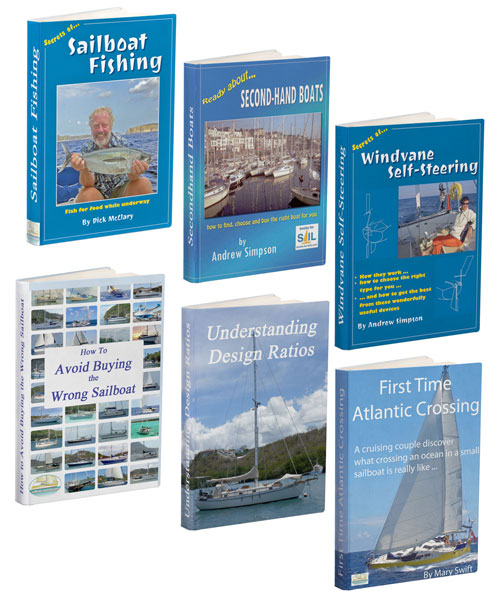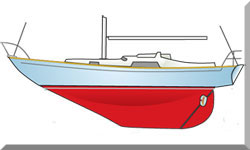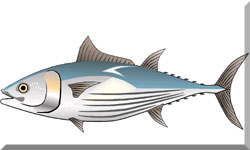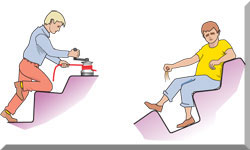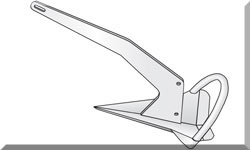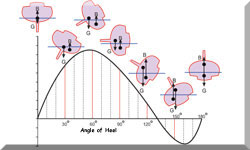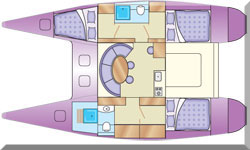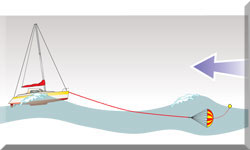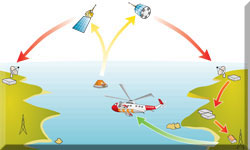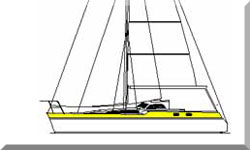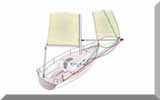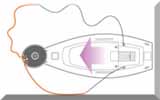Sailboat Tillers vs Wheel Steering
In a Nutshell...
When it comes to sailboat tillers versus wheel steering, the choice often comes down to a balance of a boat's size, its intended use, and a sailor's personal preference. A tiller, being a direct extension of the rudder, offers superior feedback and simplicity, making it a great choice for smaller, more responsive boats and for sailors who value a more connected steering feel. On the other hand, a wheel provides more mechanical advantage, making it easier to handle the large steering loads on bigger boats, and offers more space and comfort in the cockpit. Ultimately, both systems have their place and their dedicated advocates in the sailing world.
 My wife Mary looking more like a biker than a sailor on the helm of this centre-cockpit Whitby 42
My wife Mary looking more like a biker than a sailor on the helm of this centre-cockpit Whitby 42Table of Contents
As an experienced ocean sailor, over the years I've had my share of time at the helm, and a question I often asked myself is: "Who told the marketing men that we all want to steer our boats with wheels?"
Don't get me wrong, sometimes a wheel is the only sensible option. For centre-cockpit designs, like the classic Whitby 42, the distance between the helm and the rudder makes a tiller impractical. Similarly, on large, heavy-displacement boats, the sheer force on the rudder would make a tiller inconveniently long, making it a real chore to steer.
But for most moderate-displacement, aft-cockpit boats under 45 feet or so, I'd argue that a tiller not only makes more sense, but it’s also a lot more fun to use.
There's nothing quite like sitting out on the coaming with a tiller extension in your hand, helming the boat like a large dinghy. It's an incredibly direct and involving experience. I still remember doing this for hours when we first built our boat, Alacazam, a light-displacement cruiser that responds enthusiastically to that kind of hands-on involvement. I even positioned the primary and secondary winches a 'bum-width' apart just for that purpose. Strangely, over the years, those winches seem to have got closer together. Strange that...
When I see a boat with twin wheels, my first thought is usually, "What's the point?" While some might think they offer a kind of redundancy, that's rarely the case. In most systems, both wheels share the same linkage, so if that fails, you're out of luck on both sides. On a conventional cruising boat, they just don't seem to make a lot of sense. The only real case for them is on wide-sterned racing yachts, where they allow the helmsman to get a better view of the sails, especially the headsail, from either side of the cockpit. For a cruiser, I think it's more of a fashion statement than a functional improvement.
 Maybe a tad too much weather helm, Mary? Perhaps drop the mainsheet car down the track a little? And perhaps I should have tidied up the sheets before taking the photograph...
Maybe a tad too much weather helm, Mary? Perhaps drop the mainsheet car down the track a little? And perhaps I should have tidied up the sheets before taking the photograph...The Tiller's Case for Simplicity & Feel
Now that I've confessed my preference for tiller steering, let me explain why. It’s a beautifully simple system that offers some significant benefits.
- Ultimate Feel & Feedback: The tiller is a direct attachment to the rudder, so you get an immediate and unfiltered feel for what's going on under the water. You can sense changes in rudder load, the slight vibrations of water flowing over the blade, and the boat's balance in an intuitive way that a wheel simply can't match. It’s like the difference between driving a car with power steering and an old classic without it.
- Space & Ergonomics: A tiller takes up less space in the cockpit than a wheel, and when you're at anchor, you can lift it up out of the way, leaving the cockpit completely clear for socialising. When sailing, you can steer with the tiller between your legs, leaving your hands free to trim the jib, the mainsheet, and — if you're feeling brave — even the spinnaker, all without disturbing the off-watch crew. You can also huddle under the sprayhood to stay out of the elements.
- Reliability & Low Maintenance: By virtue of its mechanical simplicity, a tiller system is incredibly robust and reliable. There's little to go wrong and little to maintain. This is a huge advantage, especially for an ocean passage, where you want to minimise complex systems that could fail miles from shore.
- Self-Steering Versatility: Tillers work well with a variety of self-steering solutions, from simple electronic autopilots to complex windvane servo-pendulum gears. The direct connection makes integration straightforward and efficient.
The Case for Wheel Steering
While I have my bias, I can’t deny that a wheel also has its merits, especially on larger boats.
- Mechanical Advantage: A wheel system can be geared down to make steering manageable, even under high rudder loads. This is a crucial feature on larger, heavier boats where the forces on the rudder would make a tiller impractical and tiring.
- Steering Position & Visibility: On a modern, wide-sterned yacht, a wheel allows the helmsman to sit or stand in a variety of positions, which can improve visibility of the sails, the instruments, and the horizon. This is especially true for twin-wheel setups where the helmsman can move to the high side for a clear view.
- Familiarity: For many people, a wheel feels more familiar, as it operates much like a car steering wheel. This can make it easier for new or less experienced crew to get a feel for the boat.
The Hidden Complexity of Wheel Steering
The simplicity of a tiller system is something you learn to appreciate on long passages. A wheel, on the other hand, relies on a complex arrangement of wires, chains, and sheaves. Without regular maintenance, this system is prone to failure at the worst possible time. It's also heavy, adding weight right where you need it least on a performance-oriented boat.
A tiller gives you a direct, intimate connection with your boat. A wheel, by design, insulates you from that feedback. It's a less precise method of steering and gives the helmsman little feel for what the rudder is doing.
This might be the most convincing argument of all: every single wheel-steered boat has to have an emergency tiller. It's a legal requirement in some cases and a basic safety provision in all others. You'll find it tucked away in a locker somewhere, a simple, crude piece of metal or wood designed to be fitted to the rudder stock in the event of a steering failure. It might be a pain to use, especially in a seaway, but its existence is a pointed reminder that when all else fails, simplicity and directness are what you fall back on.
Understanding the function and purpose of a boat's steering system is crucial, just as it is to understand other fundamental aspects of your vessel. For a deeper look at the various design and safety features that make a boat seaworthy, read our guide on Mastering Sailboat Rudders & Steering Systems.
Maintenance & Longevity
When you're out on the water, the last thing you want is a steering failure. The maintenance requirements of each system are a key factor in their longevity and reliability.
- Tiller Maintenance: Tiller systems are remarkably simple. Routine checks typically involve inspecting the rudder stock connection, ensuring the pins and fittings are secure, and treating the wood or composite material to protect it from the elements. There are very few moving parts to worry about, which means less time spent on upkeep and a lower risk of mechanical failure.
- Wheel Maintenance: Wheel steering systems are far more complex. They require regular inspection of cables, chains, and sheaves for signs of wear, corrosion, or tension. Cables may need to be replaced periodically, and the gearbox and other components may need lubrication. This complexity means more maintenance tasks and a greater potential for a part to fail.
Cost & Installation
The cost difference between the two systems can be significant, both for initial installation and long-term ownership.
- Tillers: A new tiller, even a custom-made one, is generally a fraction of the cost of a complete wheel steering system. Installation is straightforward, as it's a direct mechanical connection to the rudder stock. The simplicity of the design means less labour and fewer expensive components.
- Wheels: A full wheel steering system, including the pedestal, cables, quadrant, and all associated hardware, can be a substantial investment. The installation process is far more involved and often requires a professional boatbuilder, adding to the total cost. This is a major factor for anyone considering a boat refit or a conversion.
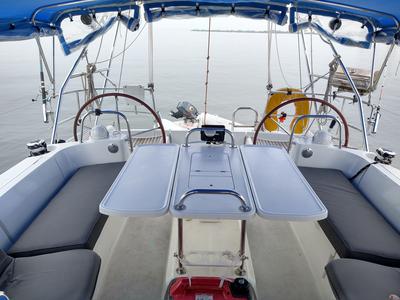 Two wheels in this aft-cockpit 44 footer! But why?
Two wheels in this aft-cockpit 44 footer! But why?Ergonomics & Comfort on Passage
While the article touches on sitting positions, let's look at the physical toll of a long passage.
- Tiller Ergonomics: On a long ocean passage, holding a tiller for hours on end, especially in heavy weather, can be physically tiring. Even with an extension, the constant physical input can strain the arms, shoulders, and back. Many sailors use an autopilot or windvane to mitigate this fatigue, but when hand steering is required, it can be a workout.
- Wheel Ergonomics: A wheel, with its mechanical advantage, makes steering much less physically demanding. The helmsman can stand or sit in a variety of comfortable positions, and the wheel's size and gearing allow for fine, low-effort adjustments. This can significantly reduce fatigue on long watches, making it a more comfortable choice for extended cruising.
Impact on Sailing Performance
For me, this is a major factor. The type of steering system has a direct impact on how the boat feels and performs.
- Tiller's Influence: A tiller provides a direct and immediate link to the rudder, giving you a tangible sense of the water flowing over the blade and the balance of the boat. This feedback loop is essential for a performance sailor, as it allows you to feel changes in weather helm and make instantaneous, subtle adjustments to optimise sail trim. It makes you a more responsive and intuitive sailor.
- Wheel's Influence: A wheel's complex linkage and gearing, while providing mechanical advantage, also create a degree of "cushioning" that dulls the feedback. It's harder to feel minor changes in the boat's balance, which can make it more challenging to find the perfect trim, especially for racing or high-performance sailing. The feedback loop is less direct and more muted.
Alternative Steering Systems
While tillers and wheels dominate the sailing world, it's worth noting other systems, such as hydraulic steering. These are typically found on large sailing yachts and superyachts where the forces on the rudder are immense. A hydraulic system uses fluid pressure to move the rudder, offering effortless steering and precision, but at the cost of complexity, expense, and a complete lack of helm feedback.
Summing Up
The choice between a tiller and a wheel is more than just a matter of functionality; it's a reflection of your sailing philosophy. The tiller-steered boat is often more of a sailor's boat, where the feel of the helm is an integral part of the experience. It's a hands-on, connected way of sailing that gives you instant feedback and a deep understanding of your boat's behaviour. While the convenience and mechanical advantage of a wheel are undeniable for larger vessels, for me, the raw simplicity, direct feedback, and reliability of a tiller will always win out. It’s not just a steering system; it’s a direct link to the water below.
This article was written by Dick McClary, RYA Yachtmaster and author of the RYA publications 'Offshore Sailing' and 'Fishing Afloat', member of The Yachting Journalists Association (YJA), and erstwhile member of the Ocean Cruising Club (OCC).
Frequently Asked Questions
Can you install a tiller on a boat designed for wheel steering?
Can you install a tiller on a boat designed for wheel steering?
It's possible, but it's a major undertaking. It would require removing the wheel pedestal, dismantling the complex steering linkage, and installing a new rudder stock head that's compatible with a tiller. It’s a big job that would need an experienced boatbuilder.
What is an emergency tiller, and how do you use one?
What is an emergency tiller, and how do you use one?
An emergency tiller is a backup steering device found on wheel-steered boats. It's a simple lever that fits directly onto the rudder stock. In an emergency, you'd locate the access point, usually in the cockpit sole, remove the cover, and fit the tiller to the top of the rudder post to regain manual control of the boat.
Are tiller extensions necessary?
Are tiller extensions necessary?
Yes, a tiller extension is crucial on most boats. It’s a handle that extends from the end of the tiller, allowing you to move your body around the cockpit for better visibility or to sit comfortably on the coaming while still maintaining steering control.
Which system is better for single-handed sailing?
Which system is better for single-handed sailing?
Both systems work well for single-handed sailing. Tillers are great because you can steer with one hand or a knee while using the other hand to trim sails. Wheel steering is also effective, especially on boats with an autopilot, as you can set a course and then move around the cockpit more freely.
Which system is more expensive to maintain?
Which system is more expensive to maintain?
The simplicity of a tiller system means it requires very little maintenance and is therefore cheaper in the long run. Wheel steering, with its complex network of chains, wires, and sheaves, requires regular inspection and lubrication, and parts can be expensive to replace.
Is it true that tillers are only for racing boats?
Is it true that tillers are only for racing boats?
Absolutely not. While many racing dinghies and sports boats use tillers because of their superior feedback, they are also a great option for cruising boats of a suitable size. Many traditional and modern cruising boats under 45 feet are equipped with tillers, and their owners wouldn’t have it any other way.
Recent Articles
-
Modern Boat Electronics and the Latest Marine Instruments
Dec 20, 25 05:27 PM
Should sailboat instruments be linked to the latest boat electronics as a fully integrated system, or is it best to leave them as independent units? -
Hans Christian 43: Classic Bluewater Cruiser & Liveaboard Sailboat
Dec 10, 25 04:37 AM
Explore the Hans Christian 43: a legendary heavy-displacement, long-keel sailboat. Read our in-depth review of its specs, design ratios, and suitability for offshore cruising and living aboard. -
Planning Your Sailboat Liveaboard Lifestyle: An Ocean Sailor's Guide
Dec 06, 25 05:18 AM
Seasoned sailors share their methodical risk analysis for planning a secure Sailboat Liveaboard Lifestyle, covering financial, property, and relationship risks.
